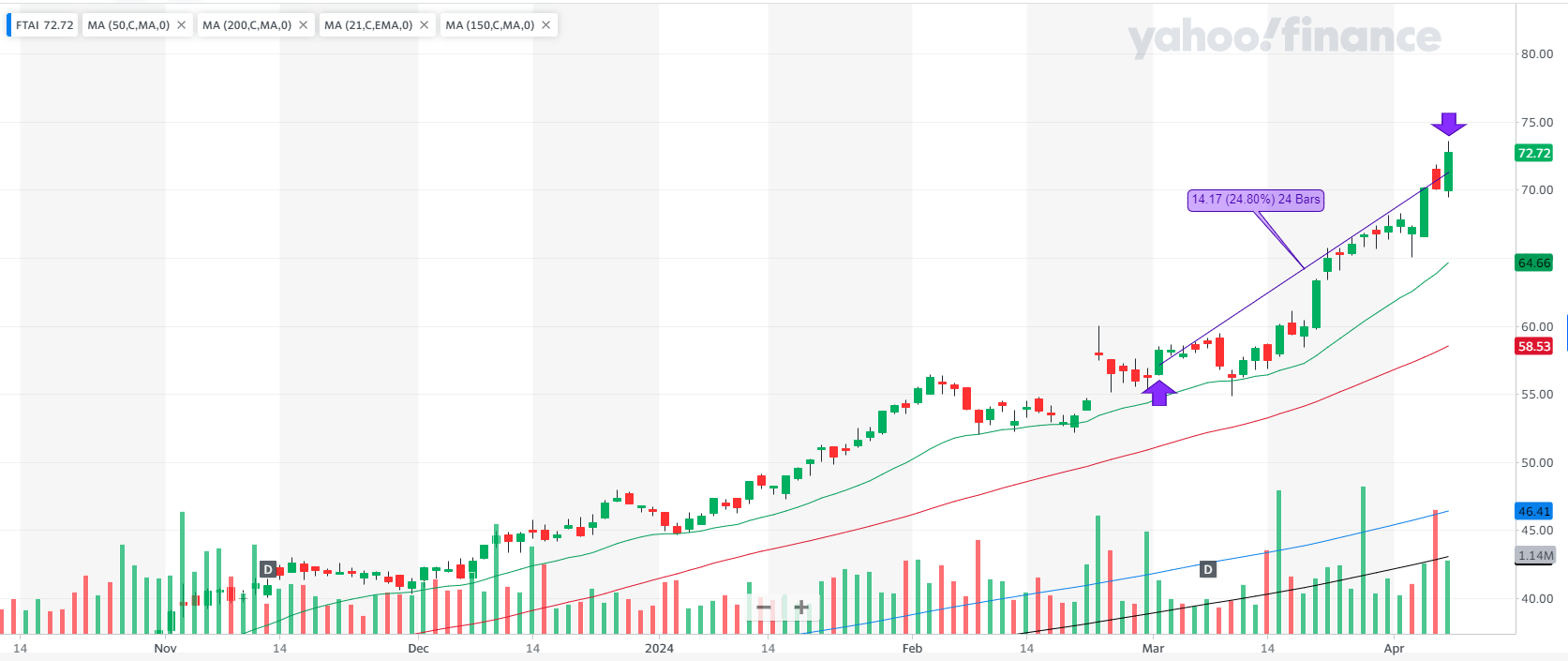The stock you own has advanced rapidly in price? What to do with it? When faced with a stock that has seen significant gains, investors often find themselves at a crossroads, contemplating the next move that would best capitalize on their position without succumbing to greed or fear. This article explores three potential strategies: keeping hold of the stock, selling it, or opting for a very tight stop-loss, the latter being the route I chose.
Keep Holding It
And why not keep holding onto your stock? Imagine the scenario: your stock’s price is climbing higher, and you’re on cloud nine. Holding onto it might seem like hanging onto a rocket ship bound for the moon. The allure is the dream of even higher peaks ahead.
- Pros: There’s the potential for unprecedented gains, especially if the fundamentals suggest more room to grow.
- Cons: However, gravity hasn’t been repealed—what goes up can come down, and sometimes, that descent is breathtakingly quick.
Sell It
Then comes the temptation to sell. You look at your investment, and it’s as if it’s begging you to cash out. Taking your profits and running to the hills before the potential fall seems like wisdom incarnate.
- Pros: It’s the path to immediate satisfaction, turning paper gains into real money.
- Cons: But the specter of regret looms large. What if the stock climbs even higher after you sell? Missing out on additional gains could haunt you.
Set a Very Tight Stop-Loss
Choosing a very tight stop-loss was my middle path through this financial thicket. It’s like setting a safety net under your tightrope walk. You’re still in the game, but you’ve got a plan to catch you if things turn south.
- Implementing a tight stop-loss meant I could let my investment ride the upward momentum while still protecting against a drastic downturn.
details at a glance
Explanations for the Drawing: The upward purple arrow shows where I bought the stock. The downward purple arrow shows where I sold it.
Green Line 21-day exponential moving average line (see EMA 21 below)
Red Line 50-day simple moving average line (see SMA 50 below)
Black LIne 200-day simple moving average line (see SMA 200 below)

Opening
- Underlying: FTAI
- Date Opened: 1 Mar 2024
- Underlying Price: 56.57
- Stop Loss: 54.49
- Profit Target: 67.88
- Market Outlook: Confirmed uptrend
- RS Rating: 96
- RS Line Trend: Upward (U)
- Industry Rank: 44 out of 197
- Volume U/D Ratio: 1.3
- Institutional Ownership Trend: Upward (U)
- Position Risk, %: 3.64
- Position Risk to NL, %: 0.19
- Potential Profit (Position), %: 19.82
- Risk to Reward Ratio: 0.18
- Position Size, %: 5.19
- Reason for Opening Trade: “The stock is under accumulation by institutions. The price is relatively high, indicating almost no overhead supply. Price bounced up from EMA 21.”
- Was It an Ideal Buy?: No. Price was not in the buy zone.
- Remarks: The trend is older than 1 year, adding slight risk.
Closing
- Date Closed: 5 Apr 2024
- Closing Price: 69.71
- Market Outlook at Close: Confirmed uptrend
- RS Rating at Close: 98
- RS Change: +2
- Closing Remarks: Tight stop-loss closed the position, realizing profit. The stock was highly extended.
Results
- What Went Well: “Profit exceeded the target, confirming the absence of overhead supply and rapid price increase. Achieved a 21.27% gain in 35 days with a risk of 5.19%. The timing was good, coinciding with a bounce from the EMA 21 line with strong volume.”
- Cause of Error/Improvement: “The optimal buying time was in November 2023, during a breakout from a base. Should buy more after a 2% initial profit when the stock bounces off EMA 21.”
- Lessons Learned: “EMA 21 is a strong buying indicator, comparable to breakout signals. Important to manage risk by setting a stop-loss 3 to 5% below the purchase price.”
- Position ROI, %: 21.27
- Position ROI (Portfolio), %: 1.10
- Position Open Time (Trading Days): 24
- Position Open Time (Days): 35
terms and definitions

Highly Extended Stock: A stock whose price has soared rapidly, often raising questions about sustainability.
Stop-Loss: An order to sell a stock when it reaches a certain price, designed to limit an investor’s loss on a position.
EMA 21 Calculates the 21-period exponential moving average, highlighting short-term trends.
SMA 50 Averages the price over 50 periods, showing medium-term trends without overemphasizing recent data.
SMA 200 Averages the price over 200 periods, revealing long-term trends by treating all data equally.
Industry Rank Investor’s Business Daily’s system that ranks industries 1 to 197 based on performance. It guides us in CAN SLIM TRADING towards leading sectors.
U/D Ratio Measures stocks closing up versus down. A ratio above 1.0 indicates bullish sentiment, important in CAN SLIM TRADING.
RS Rating Ranks a stock’s performance on a 1 to 99 scale. I look for at least 85, showing strong momentum and growth potential.
RS Line Compares stock price to the market, plotted as a ratio. We seek an uptrend, indicating outperformance and strong momentum.
Volatility Measures how much a security’s price fluctuates over time. High volatility means large price changes, indicating risk and potential reward.
Institutional Ownership Trend indicates whether the stock is under accumulation or distribution by the institutions.
EPS (Earnings Per Share): A financial metric calculated by dividing a company’s net profit by the number of its outstanding shares. It indicates the amount of profit attributed to each share of stock, serving as a key indicator of a company’s profitability.
Overhead Supply: is a stock market term for a large amount of unsold shares at a certain price level, acting as resistance that prevents the price from rising. It occurs when investors looking to sell at break-even points add to the supply, making it hard for the stock to increase in value until this excess is bought up.
conclusion
Navigating the highs and lows of the stock market can often feel like you’re trying to solve a puzzle without all the pieces. Do you hold onto a soaring stock, sell it off for a tidy profit, or hedge your bets with a safety net? It’s a decision that doesn’t come with a one-size-fits-all answer, but rather depends on your personal risk tolerance, financial goals, and perhaps a bit of gut instinct.
And while making these decisions, remember, the stock market is as unpredictable as the weather. Today’s sunshine can be tomorrow’s storm. So, whether you decide to ride the wave, cash in your chips, or protect your gains with a stop-loss, the key is to make a decision that lets you sleep at night without second-guessing yourself at every turn.
Each strategy offers a different path, each with its own set of risks and rewards. My choice? A very tight stop-loss, which led me to realize a gain of 21.27% in just 35 days.


